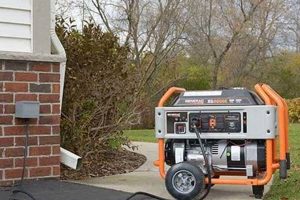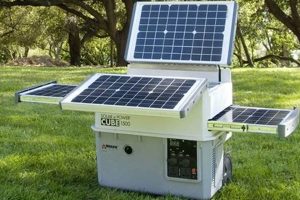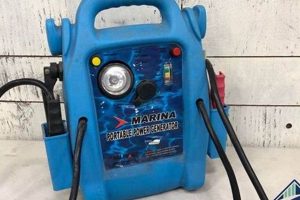Mobile, independent electricity generation is achieved through compact internal combustion engine-driven devices. These devices offer a versatile power supply for various applications, ranging from recreational activities like camping and tailgating to emergency backup power for homes and businesses. For example, during a power outage, these units can power essential appliances such as refrigerators, lights, and medical equipment. They also serve as a reliable power source in locations lacking grid access, enabling activities like construction work or powering remote monitoring stations.
The ability to produce electricity on demand, independent of a fixed power source, provides significant advantages. This independence is particularly crucial during natural disasters or emergencies, ensuring continuity of essential services and communication. Historically, access to electricity was limited by proximity to power lines. The development of these independent power sources marked a significant advancement, empowering users with greater mobility and flexibility in their electricity needs. This portability has fostered innovation in numerous fields, from disaster relief to remote area development.
The subsequent sections will delve into the various types of these independent power systems, exploring their respective power outputs, fuel sources, and ideal applications. Furthermore, considerations for selecting and safely operating these devices, including maintenance and fuel storage, will be addressed.
Operating and Maintaining Independent Power Sources
Proper operation and maintenance are crucial for ensuring the safe and effective use of independent power generation equipment. Adherence to these guidelines will prolong the lifespan of the equipment and mitigate potential hazards.
Tip 1: Regular Maintenance: Conduct routine maintenance as outlined in the manufacturer’s instructions. This includes oil changes, air filter cleaning/replacement, and spark plug inspection.
Tip 2: Proper Fuel Storage: Store fuel in approved containers in a well-ventilated area away from ignition sources. Rotate fuel stock to prevent degradation and ensure usability.
Tip 3: Ventilation: Operate units in open, well-ventilated areas to prevent carbon monoxide buildup. Never operate them indoors or in enclosed spaces.
Tip 4: Grounding: Ensure proper grounding to minimize the risk of electrical shock. Consult a qualified electrician if grounding requirements are unclear.
Tip 5: Load Management: Avoid overloading the generator. Prioritize essential appliances and distribute the load evenly within the unit’s capacity.
Tip 6: Cool-Down Period: Allow the generator to cool down before refueling. Hot surfaces can ignite fuel vapors.
Tip 7: Professional Inspection: Periodically have the unit inspected by a qualified technician to identify and address potential issues before they escalate.
Adhering to these practices ensures the safe and reliable operation of independent power sources. Careful attention to maintenance and safe operating procedures contributes to efficient performance and longevity.
The information provided herein offers valuable insights into the effective use of portable power generation. By following these guidelines, users can harness the benefits of independent electricity safely and responsibly.
1. Portability
Portability is a defining characteristic of independent power generation units, directly influencing their usability and suitability for various applications. The ease with which a unit can be transported and deployed significantly impacts its practical value in scenarios ranging from recreational activities to emergency response.
- Weight and Dimensions
The physical size and weight of a unit dictate its portability. Smaller, lighter units are easily transported by a single individual, ideal for camping or tailgating. Larger, heavier units may require wheeled transport or multiple individuals for relocation, often employed for construction sites or backup power for larger structures. Manufacturers often provide weight and dimension specifications to aid selection.
- Form Factor and Design
The overall design contributes to portability. Units with integrated handles, wheels, or compact frames enhance mobility. Folding handles and removable components further reduce storage space requirements. Consider the intended use environment when evaluating form factor; a rugged, impact-resistant design suits construction sites, while a more compact design may suffice for recreational use.
- Transportation Considerations
Transporting a unit requires considering vehicle capacity and access to the deployment location. Compact cars may accommodate smaller generators, while trucks or trailers may be necessary for larger models. Difficult terrain or limited access may necessitate specialized transport solutions, influencing unit selection.
- Setup and Deployment
Ease of setup and deployment is integral to portability. Quick-connect fuel lines, straightforward starting procedures, and integrated control panels streamline operation. The time and effort required for setup and deployment directly influence the unit’s practicality, especially in time-sensitive situations like emergencies.
The portability of a power generation unit significantly impacts its suitability for specific applications. Balancing the desired power output with the practical limitations imposed by size and weight is crucial for effective utilization. Careful consideration of these facets ensures optimal selection and enhances the overall value of independent power generation.
2. Power Output
Power output, measured in watts or kilowatts, represents a critical factor in selecting portable power generation equipment. This output determines the capacity of a generator to operate electrical devices. A direct correlation exists between power output and the number and type of appliances a generator can support. Understanding power requirements for intended devices is crucial for selecting a unit with sufficient capacity. For instance, a small generator with a 2000-watt output might suffice for powering essential lights and a refrigerator during a power outage, whereas a construction site requiring simultaneous operation of power tools would necessitate a significantly higher output, potentially 10,000 watts or more. Underestimating power needs can lead to overloading and potential damage to both the generator and connected devices.
Matching power output to specific applications ensures efficient and safe operation. Calculating total power draw by summing the wattage requirements of all intended devices provides a baseline for generator selection. A safety margin above the calculated total load is recommended to accommodate surges and prevent overloading. Furthermore, the type of load, whether resistive (lights, heaters) or inductive (motors, compressors), impacts generator selection. Inductive loads require a higher starting wattage, influencing the generator’s surge capacity requirements. Consideration of both continuous and surge power demands is essential for reliable performance.
Effective portable power utilization hinges upon accurate assessment of power requirements. Consequences of inadequate power output range from inconvenient interruptions to equipment damage. Careful evaluation and selection of a generator with appropriate power output ensure reliable operation and maximize the benefits of independent power generation. This informed approach empowers users to effectively utilize portable power across diverse applications, from recreational activities to essential emergency preparedness.
3. Fuel Type
Fuel type significantly influences the operational characteristics of portable power generators. The choice of fuel impacts not only the generator’s performance but also its environmental footprint, cost of operation, and logistical considerations. Understanding the advantages and disadvantages of various fuel types is crucial for selecting the most appropriate generator for a given application.
- Gasoline
Gasoline-powered generators are widely available and offer a good balance of portability, power output, and cost. They are commonly used for recreational activities, home backup power, and small-scale construction projects. However, gasoline has a limited shelf life and requires proper storage. Its flammability also necessitates careful handling and storage procedures.
- Diesel
Diesel generators are known for their durability, fuel efficiency, and longer runtimes. They are often preferred for heavy-duty applications, industrial settings, and large-scale backup power solutions. While diesel fuel has a longer shelf life than gasoline, it can gel in cold temperatures, requiring specific handling in colder climates. Diesel generators also tend to be larger and heavier than gasoline counterparts.
- Propane
Propane offers a cleaner-burning alternative to gasoline and diesel. Propane-powered generators produce fewer emissions and the fuel has an extended shelf life. Propane’s availability in readily portable tanks makes it convenient for recreational use. However, propane generators may offer lower power output compared to gasoline or diesel models, and the fuel itself can be more expensive in some regions.
- Natural Gas
Natural gas-powered generators provide a cost-effective and relatively clean energy source, particularly for stationary applications. Connection to a natural gas line eliminates the need for refueling, offering continuous operation. However, natural gas generators are less portable due to the requirement for a fixed fuel source and are generally unsuitable for mobile applications. Their installation often requires professional assistance and adherence to local regulations.
The choice of fuel type significantly impacts the suitability of a portable generator for a specific application. Considerations such as power requirements, runtime needs, fuel availability, cost, and environmental impact should guide the selection process. Understanding the nuances of each fuel type empowers users to make informed decisions, optimizing the benefits of portable power generation.
4. Runtime
Runtime represents a critical operational parameter for portable power generators, defining the duration a unit can operate continuously on a single fuel tank. This duration directly influences the practical usability of a generator, impacting its suitability for various applications. Runtime is inextricably linked to fuel tank capacity and fuel consumption rate. A larger fuel tank generally translates to a longer runtime, assuming a constant consumption rate. However, the actual fuel consumption rate varies based on the generator’s load. Operating a generator near its maximum power output will result in higher fuel consumption and consequently, a shorter runtime compared to operating it under a lighter load.
Consider a scenario requiring backup power during a power outage. A generator with a longer runtime ensures continued operation of essential appliances for an extended period, reducing disruption. Conversely, a shorter runtime necessitates more frequent refueling, potentially inconvenient or even impossible during prolonged outages. In construction or remote work scenarios, runtime dictates the duration of uninterrupted operation, impacting project timelines and efficiency. Understanding the interplay between runtime, fuel tank capacity, and load is essential for effective planning and operation. For instance, a generator with a 10-gallon fuel tank and a consumption rate of 1 gallon per hour at half load offers a theoretical runtime of 10 hours. However, operating the same generator at full load might increase the consumption rate to 1.5 gallons per hour, reducing the runtime to approximately 6.7 hours. This understanding allows users to estimate operational durations and plan refueling accordingly.
Effective portable power management necessitates careful consideration of runtime. Accurately estimating runtime requirements based on anticipated loads and fuel consumption rates ensures uninterrupted operation and maximizes the utility of portable generators. This understanding allows for informed decisions regarding fuel tank capacity and generator selection, optimizing the balance between power needs and operational duration. Failure to account for runtime can lead to inconvenient interruptions and operational inefficiencies, particularly in critical applications such as emergency power supply or remote site operations.
5. Noise Levels
Noise levels represent a significant consideration when selecting and operating portable power generators. The acoustic output of a generator can significantly impact its suitability for various applications, influencing user comfort and environmental compatibility. Excessive noise can disrupt activities, disturb neighbors, and even violate local noise ordinances. Understanding the factors influencing generator noise and available mitigation strategies is crucial for responsible and effective operation.
- Decibel Ratings and Measurement
Generator noise is typically measured in decibels (dB). Manufacturers often provide decibel ratings at specific distances, typically at a distance of 7 meters (23 feet). A lower decibel rating indicates a quieter operation. Understanding these ratings allows for comparison between different generator models and facilitates informed decision-making based on noise sensitivity requirements. For instance, a generator rated at 60 dB at 7 meters is significantly quieter than one rated at 75 dB at the same distance. This difference can be substantial in real-world scenarios, influencing user comfort and environmental impact.
- Factors Influencing Noise Output
Several factors contribute to a generator’s noise output. Engine size and type, load, and enclosure design all play a role. Larger engines generally produce more noise than smaller ones. Operating a generator at full load typically results in higher noise levels compared to operating it under a lighter load. Generators with enclosed designs often operate more quietly than open-frame models, as the enclosure helps dampen noise. Understanding these factors enables users to anticipate and manage noise levels more effectively.
- Mitigation Strategies
Various strategies can mitigate generator noise. Sound-dampening enclosures, exhaust mufflers, and vibration-isolating mounts can significantly reduce noise pollution. Strategic placement of the generator, such as positioning it away from sensitive areas or behind barriers, can further minimize noise impact. Employing these mitigation techniques enhances user comfort and minimizes disturbance to the surrounding environment.
- Regulations and Considerations
Many localities have noise ordinances that restrict permissible noise levels, particularly during certain hours. Operating a generator in violation of these ordinances can result in fines or other penalties. Users should consult local regulations before operating a generator to ensure compliance and avoid potential conflicts. Furthermore, consideration for neighbors and the surrounding environment promotes responsible generator use. Operating a generator during nighttime hours in a residential area, even if within permissible decibel limits, can be disruptive. Thoughtful operation practices foster positive community relations and minimize noise-related disturbances.
Noise levels are an integral aspect of portable generator operation. Careful consideration of decibel ratings, factors influencing noise output, and available mitigation strategies ensures responsible and considerate use. Understanding and addressing noise-related concerns enhances the overall utility and acceptance of portable power generation, promoting harmonious coexistence with the surrounding environment and community.
Frequently Asked Questions about Portable Power Generators
This section addresses common inquiries regarding portable power generators, providing concise and informative responses to facilitate informed decision-making and responsible usage.
Question 1: How is the appropriate generator size determined?
Generator sizing depends on the intended power requirements. Calculate the total wattage of devices planned for simultaneous operation. A generator’s running watts should exceed this total. Surge wattage, crucial for starting motor-driven appliances, should also be considered.
Question 2: What safety precautions are essential during generator operation?
Operate generators outdoors in well-ventilated areas to prevent carbon monoxide poisoning. Keep flammable materials away. Ensure proper grounding to mitigate electrical shock hazards. Allow the generator to cool before refueling.
Question 3: What maintenance procedures are recommended?
Regular maintenance prolongs generator lifespan. Consult the manufacturer’s instructions for specific maintenance schedules. Typical maintenance includes oil changes, air filter cleaning or replacement, and spark plug inspection.
Question 4: What fuel storage guidelines should be followed?
Store fuel in approved, sealed containers in a well-ventilated area away from ignition sources. Rotate fuel stock, using older fuel first, to prevent degradation and ensure optimal performance.
Question 5: Can a generator be used during inclement weather?
While some generators offer weather-resistant features, direct exposure to rain or snow should be avoided. Utilize a canopy or other protective structure if outdoor operation during inclement weather is necessary.
Question 6: What are the environmental considerations associated with generator use?
Generators produce emissions. Minimize environmental impact by selecting fuel-efficient models, operating them only when necessary, and adhering to recommended maintenance practices. Consider alternative power sources, such as solar panels, when feasible.
Careful consideration of these frequently asked questions enhances safe and efficient generator operation, maximizing the benefits of portable power while minimizing potential risks and environmental impact.
The following section will delve into advanced topics concerning portable power generation, including inverter technology and load management strategies.
Portable Power Generators
This exploration of portable power generators has highlighted their crucial role in providing independent electricity across diverse applications. From recreational activities to emergency preparedness and professional work, these devices offer essential power solutions. Key considerations, including power output, fuel type, runtime, noise levels, and portability, directly influence generator selection and effective utilization. Safe and responsible operation requires adherence to established safety guidelines, regular maintenance, and careful fuel management. Understanding these aspects empowers users to harness the full potential of portable power generation.
As technology continues to advance, ongoing innovation in portable power generation promises enhanced efficiency, reduced environmental impact, and expanded applications. Careful consideration of individual needs and responsible operational practices will ensure the continued utility and value of portable power generators in meeting evolving power demands across various sectors.






